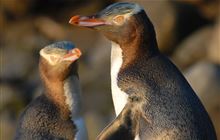Annual yellow-eyed penguin breeding results remain low
Archived content: This media release was accurate on the date of publication.
Introduction
DOC and Yellow-eyed Penguin Trust estimate there are 250 breeding pairs of yellow-eyed penguins/hoiho along the Otago and Southland coastline as their annual breeding season comes to an end.Date: 05 February 2018
This estimate is similar to the past two seasons (c. 250 and 260) but considerably lower than historically where there have been between 400-600 breeding pairs.
The monitoring identified some regular issues for the nationally endangered penguins, such as avian diphtheria in chicks and predation injuries at sea. Like last season, this year there have been some unexplained adult deaths. Further investigation into these deaths indicate signs and symptoms which are consistent with previous events. In a 2013 event 67 hoiho were found dead and in 2017 six were confirmed to have died, all in similar circumstances.
DOC's Coastal Otago Operations Manager Annie Wallace says, "so far two adult hoiho have been found dead on Otago beaches in the last week. We need to take into account similar events in previous years occurring in the same months. Despite much research into the reasons for these deaths and the ruling out of many possibilities, the exact cause has not yet been identified."
Yellow-eyed Penguin Trust Science Advisor Trudi Webster says, "after last season we created an operational plan for any future recurrences of unexplained adult deaths. We had hoped it would not be operational quite so soon. We are collecting as much information as possible to assist those who are working with us to identify the reasons for the deaths. This includes sending fresh samples to Wildbase at Massey University for analysis."
Where a dead adult can be identified and located to an active nest, the chicks will be transferred to a rehabilitation centre in Otago (Penguin Place or Penguin Rescue). Here they will receive supplementary feeding and care so that they are in optimum condition for when they fledge (from mid-February).
DOC carries out monitoring, research and intensive management for yellow-eyed penguins alongside Treaty Partner Ngāi Tahu, key programme partner the Yellow-eyed Penguin Trust, important local associates University of Otago, Penguin Rescue, Penguin Place and many community groups and volunteers.
The Department is asking that the public help to protect these nationally endangered penguins, particularly through their vulnerable moulting season (end of February to mid-April), by keeping dogs under control and giving the birds plenty of space.
"As part of the monitoring we are also on the lookout for any underweight adult birds so that, where necessary, we can take them into rehabilitation for supplementary feeding before they enter their annual moult," says Annie Wallace.
"Please call DOC's Hotline on 0800 DOC HOT (0800 362 468) if you come across yellow-eyed penguins along the Otago and Southland coastline and are concerned about their condition, describing as accurately as possible where the bird is located."
Contact
For media enquiries contact:
Email: media@doc.govt.nz

